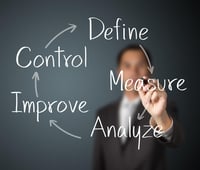So Your Industrial Sales Team Isn't Hitting Quota...
Whether you sell capital equipment, consumables, or services, it's likely that you're losing more to the status quo (no decision), having a harder time finding projects, and seeing more opportunities die slow deaths in the pipeline.
Let's assume that your product is good, your industry remains viable, your pricing is appropriate, and your company has a solid reputation.
What do you do?
If you're like most companies you've probably considered some sort of sales consultant or trainer. Maybe you've even hired one.
But is that the right answer?
First, Is It Even a Sales Problem?
 Let's back up to understand how companies buy - better yet how individuals work as part of buying teams to make complex purchase decisions for companies.
Let's back up to understand how companies buy - better yet how individuals work as part of buying teams to make complex purchase decisions for companies.
You have certainly heard the basic statistics:
- buyers are 70% of the way through their buying journey before they want to talk to a sales person
- 93% of B2B procurement starts on the internet
- 74% of the time companies buy from the vendor that first helped them understand their requirements
- complex buying teams average 10.2 buyers
- only 3% of potential buyers are in the market at any given time
So before you start worrying about sales training in SPIN, BANT, BASHO, MEDDIC sales or any of many other sales process models, the first question is whether you're identifying and connecting with buyers early enough in the process.
Understanding the buying journey and how capital equipment and machinery sales happen is fundamental.
You've got to be strongly invested in digital marketing with the right tools, sophisticated SEO, great content and optimization at each step of the process (getting found, clicked, engage, convert, nurture) to ensure your generating appropriate industrial sales leads throughout the buying journey.
Then you can start to look at sales.
And yes, it is an industrial sales problem. However, it's not JUST a sales problem.
Lead Management, Pipeline Management, Knowledge Sales
In 15 minutes you can set up a system to send quotes automatically. You don't need a sales trainer for that. You don't need sales people to satisfy prospect quote requests reflexive demands.
Now, I know...your industry is different. 🤣
Actually, it's not.
EVERY company I work with thinks they have a lead generation problem. And most do. But once the leads start to flow they gradually have to acknowledge a sales problem. Leads are rarely worked effectively. Pipelines aren't properly qualified and managed. And most sales people are simply administrators - even some of your experienced and "successful" veterans.
Topline industrial sales relies on a much deeper set of skills than roll playing the right way to turn a phrase, or calculating the activity levels required to hit sales goals given quota, deal size, close rates and sell cycle.
Social selling, sales video, business finance, data analysis, writing, research, and story telling are all important skills; and skills that B2B sales consultants don't typically bring.
Instead they focus on their same (often tired) franchised sales process model.
A Manufacturing Marketing & Sales Strategy - Unified, Predictable Revenue Growth
 The problem facing most companies is actually bigger.
The problem facing most companies is actually bigger.
Sales trainers probably aren't the full answer. But neither are most inbound or content marketing agencies. They may check the boxes with blogs, offers, landing pages, HubSpot or Marketo marketing automation, chatbots, SEO and other tactics and tools, and sales operations checklists, but they don't understand industrial markets.
And behind it all, the sales trainers don't understand digital marketing - just as the digital marketers don't understand machinery sales and other industrial situations.
Yet, from the buyers perspective the engagements they have with your marketing need to be sales experiences, and the engagements they have with your sales team need to be educational (almost like marketing.)
You see, the functions are now largely conflated - but from the buyers perspective that doesn't matter. They have one experience with your company regardless of what department you want to call it.
And that brings us back how to solve for top-line revenue growth.
Manufacturing Revenue Growth
 Buyers expect to have a contiguous experience with your marketing and sales.
Buyers expect to have a contiguous experience with your marketing and sales.
So that's what you need to provide.
That means digitally enabled in and outbound marketing, coordinating closely with in and outbound sales. They need to work together using tactics and tools guided by a strategy which contemplates the entire journey from the buyers' perspective and brings that understanding to interactions with each of the more than 10.2 buyers on a typical capital equipment buying team, and at each stage in the journey.
The details of the email templates and call scripts are important, but only once you've solved for the big picture challenge.
So before you chase after a leads generation service, a manufacturing marketing firm that specializes in HubSpot and inbound marketing, a B2B sales expert or trainer or some other symptom focused solution, step back and look at the overall program.
If you're trying to apply a circa 2005 treatment to a symptom, it's likely to fail. Instead the important first step is to adapt your revenue growth model to a 2021 procurement environment.
More Thoughts on the Role of B2B Sales Consulting in Crafting an Integrated Sales and Marketing Strategy for Sustainable Growth
 Sustainable revenue growth leads to a complex web of questions and challenges. The complexity of these challenges requires a multifaceted approach, blending various elements of industrial sales and manufacturing marketing. Sales training is one piece, but only effective once a larger framework and mindset are in place. In this context, the role of sales teams and sales consultants becomes crucial. They are not just the folks who help implement strategies, but also key in shaping and driving these strategies forward.
Sustainable revenue growth leads to a complex web of questions and challenges. The complexity of these challenges requires a multifaceted approach, blending various elements of industrial sales and manufacturing marketing. Sales training is one piece, but only effective once a larger framework and mindset are in place. In this context, the role of sales teams and sales consultants becomes crucial. They are not just the folks who help implement strategies, but also key in shaping and driving these strategies forward.
Harnessing the Power of Sales Consultants and Teams
Sales consulting services are no longer about just imparting training or providing temporary fixes. Modern sales consultants are strategic partners who work closely with businesses to understand their unique challenges and opportunities. This involves thoroughly analyzing existing sales strategies and their alignment with the company's overall goals. Sales consulting experts bring in a fresh perspective, often identifying areas of improvement that internal teams might overlook.
Building a Successful Sales Team
The cornerstone of any effective sales strategy is a successful sales team. This team comprises not just sales reps with impressive track records but also individuals who are adaptable, skilled in various sales methodologies, and capable of understanding complex customer needs. The emphasis here is on continuous learning and adaptation, as the landscape of B2B sales and lead generation is ever-evolving. That requires sales leaders and sales managers who balance innovation and openness to new ideas with a deep understanding of a company's heritage and buyers.
Integrating Sales Consulting with B2B Sales Efforts
In the realm of B2B sales consulting, the focus is on creating strategies that resonate with the unique dynamics of business-to-business transactions. This involves a deep understanding of the market, the competition, and the specific pain points of potential clients. Sales consulting experts must tailor their approaches to these unique challenges, ensuring that their strategies are not just effective but also relevant.
After all, nobody actually cares about the product you are selling. They are only interested in the business outcomes and personal/professional impact they realize.
Emphasizing Business Planning and Marketing Consulting
A pivotal aspect often overlooked in sales strategies is the integration of business planning and marketing consulting. While sales focus on closing deals, marketing is about creating the right environment for these deals to happen - particularly in a world where buyers are 70% of the way through their journey before they want to speak to a sales rep. This involves comprehensive market research, understanding the journey of customer success, and maintaining healthy relationships with existing customers and existing accounts.
Offering Customized Solutions for Diverse Needs
Every business has its unique set of challenges and opportunities. Therefore, customized solutions are essential for addressing specific needs. This customization extends to sales training, strategy development, revenue operations, and even the way sales teams interact with potential clients. The goal is to achieve sustainable growth by creating solutions that are not just effective in the short term but also scalable and adaptable in the long run.
Unlocking Sales Potential through Ongoing Support
One of the key roles of a B2B sales consultant is to unlock the latent sales potential within an organization. This is achieved through ongoing support, regular training sessions, and continuous engagement with the sales team. The consultant's role is to ensure that the sales team is not just equipped with the right tools and strategies but is also motivated and aligned with the company's broader business goals.
An Integrated Framework of Manufacturing Marketing and Industrial Sales
Integration of sales and marketing strategies, backed by sales consultants' expertise, is imperative for businesses seeking sustainable growth. The approach needs to be holistic, addressing not just immediate sales targets but also the company's broader objectives. By building a robust sales team, leveraging sales consultants' expertise, and ensuring continuous improvement and adaptation, businesses can navigate the complexities of the modern market and achieve their long-term goals.


